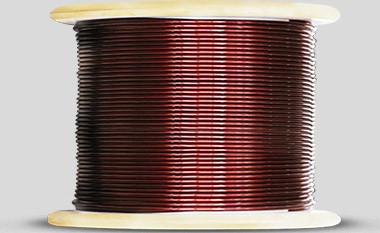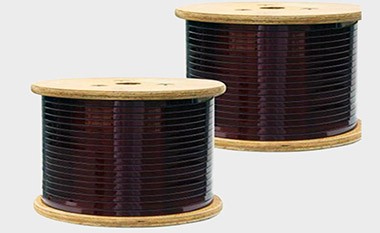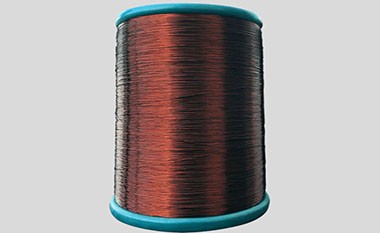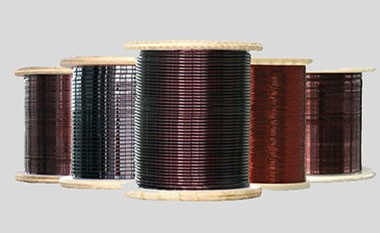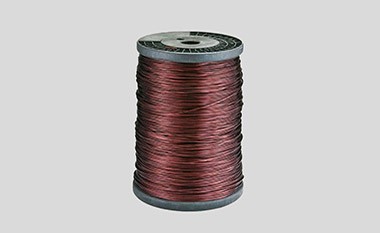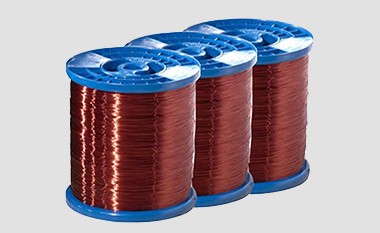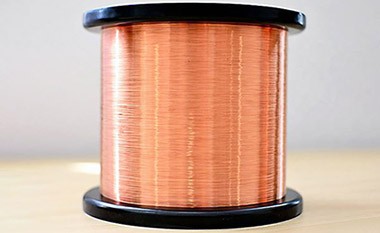Enameled Copper Clad Aluminum Wire(ECCA)
Copper Clad Aluminum Enamelled Wire (ECCA) is a new type of electromagnetic wire made from copper-clad aluminum materials, combining the excellent conductivity of copper with the lightweight advantages of aluminum.
Enameled Copper Clad Aluminum Wire (ECCA) is produced from copper-clad aluminum (CCA) wire with an insulating enamel coating.
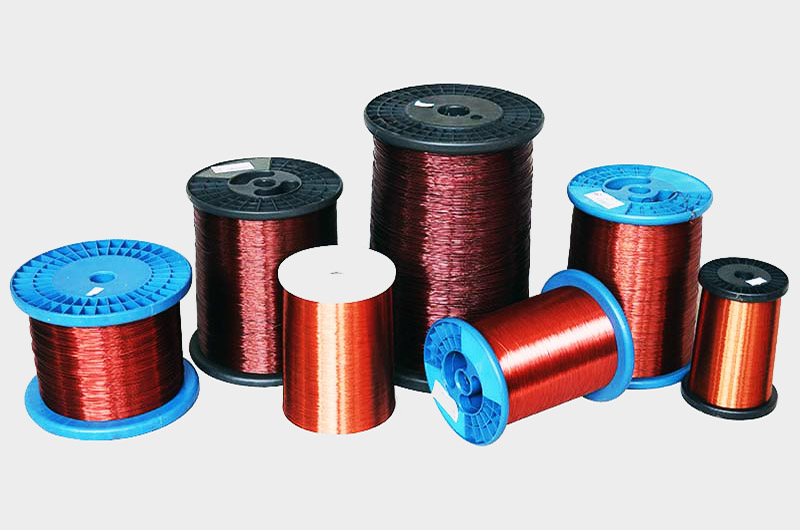
Material Composition of Enameled Copper Clad Aluminum Wire
ECCA is a novel electromagnetic wire primarily composed of a copper-clad aluminum conductor and an enamel insulation layer.
- Copper Clad Aluminum Conductor (CCA): The copper-clad aluminum wire consists of an aluminum core wrapped in a copper layer. This structure allows the conductor to maintain high conductivity while reducing overall weight. Since aluminum has a much lower density than copper, CCA conductors are lighter for the same level of conductivity.
- Enamel Layer: The enamel layer is an insulating coating made from high molecular materials like polyester and polyamide, effectively preventing short circuits between conductors and improving electrical insulation performance.
Enameled Copper Clad Aluminum Wire (ECCA) Parameters
- Round Wire Diameter Range: 0.08mm - 8.00mm
- Thermal Class: 130°C, 155°C, 180°C, 200°C, 220°C
- Standards: IEC60317, NEMA MW1000, JIS C3202/ASTM B 566-93
Features of Enameled Copper Clad Aluminum Wire (ECCA)
- Excellent Conductivity: The conductivity of copper is significantly higher than that of aluminum, allowing copper-clad aluminum wire to provide good current transmission while remaining lightweight.
- Lightweight: Compared to pure copper wire, copper-clad aluminum enameled wire is lighter, making it suitable for applications where weight is critical, such as in aerospace and automotive fields.
- Corrosion Resistance: Aluminum itself has good corrosion resistance, and with the protective copper layer, it maintains stable performance in various environments.
- Cost-Effectiveness: The production cost of copper-clad aluminum wire is relatively low, especially during times of high copper prices, allowing for significant reductions in overall costs.
Advantages of Copper Clad Aluminum Wire
- For the same weight and diameter, the length of copper wire can be 2.6 to 3.2 times that of pure copper wire, meaning that 1 ton of pure copper wire can yield 2.6 to 3.2 tons of CCA wire, significantly lowering raw material costs for manufacturers.
- CCA wire is more ductile than copper wire, and unlike aluminum, which can form insulating oxides, it is easier to process while maintaining good conductivity.
- The lightweight nature of CCA wire makes it easy to transport and install, reducing labor costs.
- CCA wire offers significant social benefits by saving substantial amounts of copper raw material resources.
HC Aluminum Copper Clad Aluminum Wire for Sale
Round Wire Diameter Range: 0.08mm - 8.00mm
Enameled Copper Clad Aluminum Wire performance parameters table:
| Product Name | QZ-130 PEW130 | QZGB-155 PEW155 | QZ-180 EIW180 | Q(ZY/XY)-200 AI/ EIW200 |
| Standard | IEC60317 ASTM B 566-93 | IEC60317 ASTM B 566-93 | IEC60317 ASTM B 566-93 | IEC60317 ASTM B 566-93 |
| Thermal Class | 130℃ | 155℃ | 180℃ | 200℃ |
| Enamel Base Coat | Polyester | Modified Polyester | Polyester-Imide | Polyester-Imide |
| Enamel Top Coat | - | Polyamide-Imide | ||
| Heat shock | 155℃ | 175℃ | 200℃ | 220℃ |
| Cross Section Range | 0.08mm-8.00mm | 0.08mm-8.00mm | 0.08mm-8.00mm | 0.08mm-8.00mm |
| Range of insulation thickness | IEC 60317-0-1 GB6108.2-85 | IEC 60317-0-1 GB6108.2-85 | IEC 60317-0-1 GB6108.2-85 | IEC 60317-0-1 GB6108.2-85 |
| Performance | 1.excellent bendingproperty 2.high flexibility of the enamel 3.good resistance to abrasion 4.high mechanical property | 1.higher thermal property 2.excellent bendingproperty 3.high flexibility of the enamel 4.good resistance to abrasion 5.high mechanical property | 1.higher thermal property 2.suitable for windings that are subjected to constantly high temperature and mechanical stress 3.good chemical resistance | 1.excellent thermal resistance 2.suitable for windings that are subjected to constantly high temperature and mechanical stress 3.good chemical resistance 4.good resistance to refrigerant |
| Application |
ECCA wire widely used in Cable TV signa Large volume communications net work signal transmission Control signal cable Welding cable Electrical products. |
|||
Applications of Copper Clad Aluminum Enamelled Wire
Motors and Transformers
Winding: In motors and transformers, copper clad aluminum enamelled wire effectively reduces weight while ensuring excellent conductivity, making it particularly suitable for household motors, miniature motors, and compressors, which have high environmental requirements.
Inductors and Electromagnetic Coils
Inductors: Widely used in inductors and electromagnetic coils, such as in audio equipment, display deflection coils, and demagnetizing coils, providing excellent signal transmission and stability.
Audio Equipment
Speaker Coils: Enhances sound quality and reduces signal loss, widely used in connecting wires for audio equipment.
Home Appliances
Power and Signal Wires: Used as power or signal wires in household appliances, improving device performance and safety.
Electronic Components
Inductors and Capacitors: In various electronic components, such as inductors and transformers, copper clad aluminum enamelled wire effectively enhances equipment performance and durability.
Control Signal Cables and Welding Cables
Used in specific electrical products to provide efficient signal transmission.
Manufacturing Process of Copper Clad Aluminum Enamelled Wire
Drawing
Process Description: Aluminum is drawn through a series of molds to produce wire of the desired diameter. This process typically involves multiple stages, gradually reducing from coarse to fine to ensure uniform diameter and excellent surface quality.
Notes: During the drawing process, it is essential to control the drawing speed and temperature to avoid overheating the aluminum, which could degrade its performance. Additionally, the surface of the drawn aluminum wire should remain clean to facilitate subsequent coating processes.
Coating
Process Description: Copper is coated on the outer layer of the aluminum wire, usually by electroplating or hot-dipping. The electroplating process deposits copper ions onto the surface of the aluminum wire through an electrochemical reaction, while hot-dipping uses high temperatures to bond the copper coating with the aluminum.
Notes: After coating, the wire should be cooled and checked for the uniformity and adhesion of the copper layer.
Enameled Coating
Process Description: An insulating enamel is applied to the outer layer of the copper-clad aluminum wire to form a complete enameled wire. The enameling process typically employs dipping or spraying methods to ensure an even insulation layer without bubbles.
Insulation Paint Types: Common insulation paints include polyester and polyurethane, which have good electrical insulation properties and high-temperature resistance.
Curing Process: After enameling, a curing process is necessary, usually involving heating or ultraviolet irradiation to solidify the enamel layer, enhancing insulation effectiveness and durability.
The manufacturing process of copper clad aluminum enamelled wire involves three main steps: drawing, coating, and enameling, ensuring excellent conductivity and insulation performance. These process steps complement each other, making copper clad aluminum enamelled wire widely applicable in motors, inductors, transformers, and various other fields.

